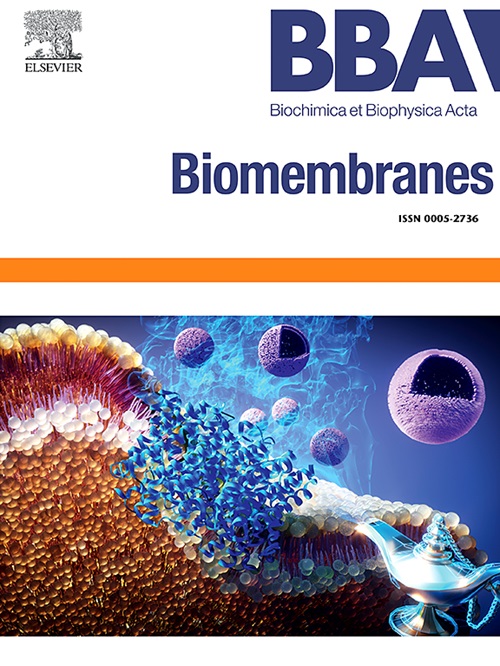淀粉样蛋白-脂质体复合材料作为阿霉素递送的混合平台
IF 2.5
3区 生物学
Q3 BIOCHEMISTRY & MOLECULAR BIOLOGY
引用次数: 0
摘要
通过在淀粉样蛋白悬浮液基质中整合磷脂囊泡来设计复杂的混合药物输送平台的可行性已经进行了评估。利用平衡透析方法和荧光光谱技术,定量分析了多柔比星(DOX)在不同磷脂组装体、淀粉样蛋白悬浮液及其相应复合体系中的包封能力。我们的研究结果表明,将带负电荷的心磷脂(CL)掺入磷脂酰胆碱(PC)脂质囊泡可显著增强DOX的包封和保留,而将淀粉样蛋白原纤维添加到带电荷的脂质体中对药物结合的影响最小。与未经修饰的脂质体相比,经胰岛素和溶菌酶纤原悬浮液修饰的中性PC脂质体表现出更好的阿霉素包封和滞留性,从而在体内显示出降低毒性和延长药物作用的潜力。值得注意的是,与脂质体相比,淀粉样蛋白原纤维单独显示出较低程度的DOX包封和保留。荧光分析表明,胰岛素和溶菌酶原纤维的存在改变了DOX的微环境,使其更加疏水,这与更深的双分子层渗透一致。释放动力学和保留研究的累积数据以及荧光测量表明,PC脂质体-胰岛素原纤维复合材料是最有前途的DOX纳米载体,具有增强的药物包封性、结构稳定性和在双分子层内的最佳药物定位。研究结果为设计蛋白质-脂质纳米材料以增强药物传递提供了有价值的见解,为开发更有效和更有针对性的治疗策略提供了有希望的途径。本文章由计算机程序翻译,如有差异,请以英文原文为准。
Amyloid-liposome composites as hybrid platforms for doxorubicin delivery
The feasibility of engineering the sophisticated hybrid drug delivery platforms through the integration of phospholipid vesicles within a matrix of amyloid suspensions has been evaluated. Utilizing the equilibrium dialysis methodology and spectrofluorometric technique, the quantitative analysis of doxorubicin (DOX) encapsulation capacity of diverse phospholipid assemblies, amyloid suspensions, and their corresponding composite systems has been performed. Our findings revealed that the incorporation of negatively charged cardiolipin (CL) into phosphatidylcholine (PC) lipid vesicles significantly enhances DOX encapsulation and retention, while the addition of amyloid fibrils to charged liposomes has minimal impact on the drug binding. The neutral PC liposomes modified with insulin and lysozyme fibrillar suspensions exhibited improved doxorubicin encapsulation and retention compared to unmodified liposomes, thereby displaying a potential for reduced toxicity and prolonged drug action in vivo. Notably, amyloid fibrils alone were found to demonstrate the lower degree of DOX encapsulation and retention as compared to liposomes. Fluorimetric analysis suggests that the presence of insulin and lysozyme fibrils alters the microenvironment of DOX towards a more hydrophobic which is consistent with deeper bilayer penetration. Cumulative data from release kinetics and retention studies along with fluorescence measurements suggest that PC liposome-insulin fibril composites represent the most promising DOX nanocarriers, combining enhanced drug encapsulation, structural stability, and optimal drug location within the bilayer. The results obtained provide valuable insights into the design of protein-lipid nanomaterials for enhanced drug delivery, offering promising avenues for the development of more effective and targeted therapeutic strategies.
求助全文
通过发布文献求助,成功后即可免费获取论文全文。
去求助
来源期刊

Biochimica et biophysica acta. Biomembranes
生物-生化与分子生物学
CiteScore
8.20
自引率
5.90%
发文量
175
审稿时长
2.3 months
期刊介绍:
BBA Biomembranes has its main focus on membrane structure, function and biomolecular organization, membrane proteins, receptors, channels and anchors, fluidity and composition, model membranes and liposomes, membrane surface studies and ligand interactions, transport studies, and membrane dynamics.
 求助内容:
求助内容: 应助结果提醒方式:
应助结果提醒方式:


